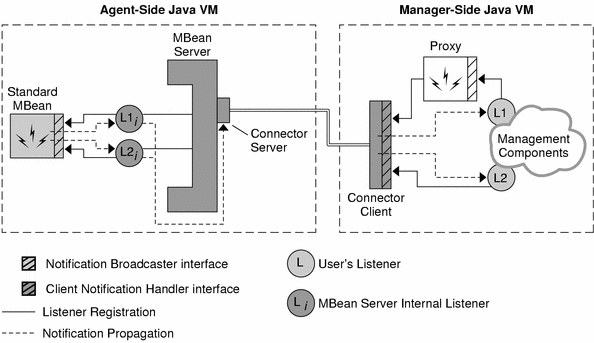22.2 Push Mode
The push mode of notification broadcasting only exists for the legacy connectors. The new connectors implemented in Java DMK 5.1 all use pull mode. Push mode is presented here purely for reasons of backwards compatibility with older versions of Java DMK.
Because the broadcaster and the listener are running on separate hosts or in separate virtual machines on the same host, their notifications must be forwarded from one to the other. The mechanism for doing this is completely transparent to the users of the Java DMK components.
Briefly, the legacy connector client instructs the legacy connector server to add its own agent-side listener to the designated broadcaster using the methods of the MBeans server. Then, the connector server implements a buffering cache mechanism to centralize notifications before serializing them to be forwarded to the connector client. By design, it is the connector client in the manager application that controls the buffering and forwarding mechanism for a connection.
Figure 22–1 summarizes the notification forwarding mechanism and its actors. In particular, it shows how the connector server uses internal listener instances to register locally for MBean notifications, even if this mechanism is completely hidden from the user. The path of listener registration through calls to the addNotificationListener method of the various interfaces is paralleled by the propagation of notifications through calls to the listeners' handleNotification method.
Figure 22–1 Notification Forwarding Internals

Neither the broadcaster nor the listener need to implement any extra methods, or even be aware that the other party is remote. Only the designer needs to be aware of communication issues such as delays. You cannot expect the listener to be invoked instantaneously after a remote broadcaster sends a notification.
The forwarding mechanism allows you to configure how and when notifications are forwarded. This enables you to optimize the communication strategy between your agents and managers. There are two basic modes for notification forwarding in legacy connectors: push mode and pull mode. A notification in the connector server's cache is either pushed to the manager at the agent's initiative, or pulled by the manager at its own initiative.
The push mode for notification forwarding is the simplest because it implements the expected behavior of a notification. When a notification is sent from an MBean to its listener, it is immediately pushed to the manager-side where the listener's handler method is called. There is no delay in the caching, and if the communication layer is quick enough, the listener is invoked almost immediately after the notification is sent.
Push mode is the default forwarding policy of a newly instantiated connector client.
In our manager example, we explicitly set the connector client in push mode and then trigger the agent-side notifications.
Example 22–4 Switching to the Notification Push Mode
System.out.println("\n>>> Set notification forward mode to PUSH.");
connectorClient.setMode(ClientNotificationHandler.PUSH_MODE);
System.out.println(">>> Have our MBean broadcast 10 notifications...");
params[0] = new Integer(10);
signatures[0] = "java.lang.Integer";
connectorClient.invoke(mbean, "sendNotifications", params, signatures);
System.out.println(">>> Done.");
System.out.println(">>> Receiving notifications...\n");
// Nothing to do but wait while our handler receives the notifications
Thread.sleep(2000);
|
The connector client exposes the methods for controlling the agent's notification buffer. This caching buffer is not used in push mode, so these methods do not affect pushed notifications. The methods do however set internal variables that will be taken into account if and when pull mode is enabled.
The advantage of push mode is that it works without any further intervention: notifications eventually reach their remote listeners. Push mode works when the communication layer and the listener's processing capacity are adapted to the notification emission rate, or more specifically to the potential emission rate. Because all notifications are immediately sent to the manager hosts, a burst of notifications will cause a burst of traffic that might or might not be adapted to the communication layer.
If your communication layer is likely to be saturated, either your design should control broadcasters to prevent bursts of notifications, or you should use the pull mode which has this control functionality built-in. The push mode is ideal if you have reliable and fast communication between your agents and your managers. You can also dynamically switch between modes, enabling a management application to fine-tune its communication policy depending on the number of notifications that must be handled.
- © 2010, Oracle Corporation and/or its affiliates
